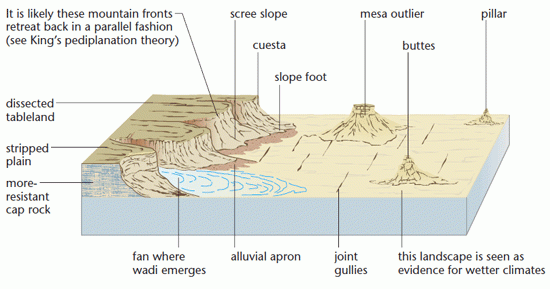Features produced by Water in Deserts
Rain does fall occasionally in deserts, and desert storms are often violent. A record 44 mm of rain once fell within 3 hours in the Sahara. Large Saharan storms may deliver up to 1 mm/minute.
Normally dry stream channels, called arroyos or wadis, can quickly fill after rain,and flash floods make these channels dangerous.
However, the evolution of arid landforms is often affected by events that occurred long ago. Past climatological conditions, reflected in many desert landforms, began to develop during pluvial periods several thousand years ago.
More people drown in deserts than die of thirst!
Channels which were once part of a perennial drainage system now receive the run-off from torrential storms, unhindered by vegetation, leaving deep alluvial debris over the wadi floor, though wind deflation may later remove much fine surface material. Surface channels on old shield areas often lead into inland drainage depressions. Many of these lake depressions have been filled by materials washed forward from the foot of the enclosing mountains, where streams entering the basin have deposited their load and created alluvial fans. In some the fans have coalesced to form a mass of material known as a bajada. Some of the material from the bajada washes forward over the pediment levelling the landscape with unconsolidated deposits.
Water can also dissect out deep wadi systems. Stream-dissected scarps overlook the older plains, where detached outliers form mesas, buttes and pinnacles.

In the USA 32% of arid landforms relate to the action of water in deserts.

- Sabkhas – an occasionally flooded desert area with an extensive thickness of evaporates (salts), usually coastal in nature.
- Duricrust – hardened areas of minerals that cover deserts. They are impermeable and thought to be due to weathering.
- Desert varnish – iron and magnesium oxides and silica coat rocks. Due to evaporation.
CASE STUDY - Lake Bonneville – a playa within a desert Lake Bonneville is the relic of a large lake that existed during the last ice age (12 000 years ago), though it probably has an origin from 50 000 years ago. It was some 52 000 km2 almost 300 m deep and was 1525 m above sea level. Climatic change caused the lake to fall below the lowest outlet. When the water evaporated it left an arid depression composed of billions of tonnes of salt and other minerals. The remnants of Lake Bonneville include Utah’s Great Salt Lake, Utah Lake and Sevier Lake.
The highest salt water lake in the world is in the Qaidam Depression, China. Ground speed records are commonly established on Bonneville speedway. The space shuttle lands on Rogers Lake Playa, at Edwards Air Force Base, California.
Equifinality
Few landforms have proven origins. Many landforms can come about through different processes and quite different conditions, e.g. pediments, dune formation inselbergs and deflation hollows may have many origins.
